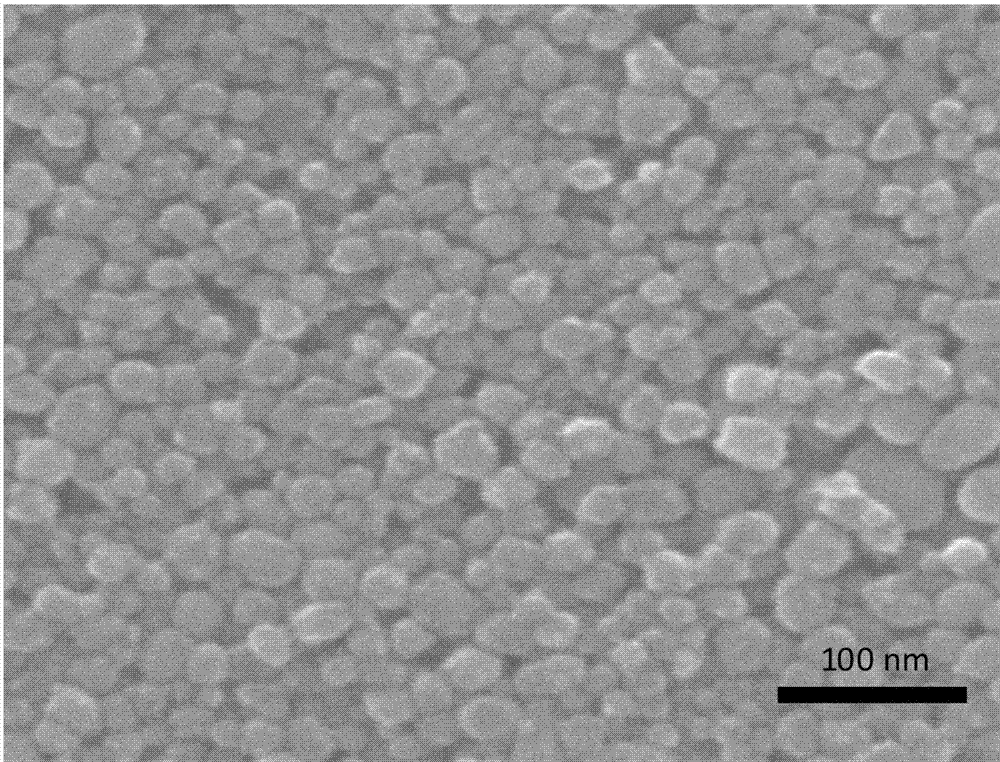Method for synthesizing copper nanoparticles
A technology of copper nanoparticles and synthesis methods, applied in the direction of nanotechnology, nanotechnology, nanotechnology for materials and surface science, etc., can solve problems such as high cost, difficulty in large-scale industrial production, and high energy consumption, and achieve cost Low, widely used in industry, promoting reduction effect
- Summary
- Abstract
- Description
- Claims
- Application Information
AI Technical Summary
Problems solved by technology
Method used
Image
Examples
Embodiment 1
[0013] 25 g CuSO 4 ·5H 2 O is placed in an 800 mL beaker, add 20 grams of water, and heat to make CuSO 4 ·5H 2 O dissolved, when CuSO 4 ·5H 2 After O is completely dissolved, add 33.3 g of PVP, stir well and add 13.2 g of NaHPO 2 ·xH 2 O, after stirring evenly, after standing at room temperature for a few minutes, a uniformly mixed blue semi-solid phase mixture is obtained, which is placed in a 700-watt microwave reaction oven, heated by microwave for 30 seconds, and the mixture quickly turns into a red copper color , after standing for 4 minutes, add 50 mL of ice water to quench the reaction, transfer the resulting mixture to a centrifuge tube, and centrifuge the copper nanoparticles, wash the obtained copper nanoparticles with 50 mL of water twice, 50 mL Washing with ethanol twice, and finally dispersing the obtained copper nanoparticles in ethylene glycol solvent, filled with nitrogen protection, to obtain a stable dispersion of copper nanoparticles.
Embodiment 2
[0015] 25 g CuSO 4 ·5H 2 O is placed in an 800 mL beaker, add 20 grams of water, and heat to make CuSO 4 ·5H 2 O dissolved, when CuSO 4 ·5H 2 After O is completely dissolved, add 6.2 grams of ethylene glycol and 33.3 grams of PVP successively, stir well and add 8.48 grams of NaHPO 2 ·xH 2 O, after stirring evenly, after standing at room temperature for several minutes, a uniformly mixed blue semi-solid phase mixture was obtained, which was placed in a 700-watt microwave oven, heated by microwave for 10 minutes, and the mixture quickly turned red copper, and placed for 1 Minutes later, add 50 mL of ice water to quench the reaction, transfer the resulting mixture to a centrifuge tube, and centrifuge the copper nanoparticles. The obtained copper nanoparticles are washed twice with 50 mL of water and twice with 50 mL of ethanol. , and finally the obtained copper nanoparticles are dispersed in ethylene glycol solvent, filled with nitrogen protection, and a stable copper nanop...
Embodiment 3
[0017] 25 g CuSO 4 ·5H 2 O was placed in an 800 mL beaker, 5 mL of water and 20 g of 1,2-diethanol were added in sequence, and the CuSO 4 ·5H 2 O dissolved, when CuSO 4 ·5H 2 After O is completely dissolved, add 6.2 grams of ethylene glycol and 33.3 grams of PVP successively, stir well and add 8.48 grams of NaHPO 2 ·xH 2 O, after stirring evenly, after standing at room temperature for several minutes, a uniformly mixed blue semi-solid phase mixture was obtained, which was placed in a 700-watt microwave oven, heated by microwave for 2 minutes, and the mixture quickly turned red copper, and placed for 8 Minutes later, add 50 mL of ice water to quench the reaction, transfer the resulting mixture to a centrifuge tube, and centrifuge the copper nanoparticles. The obtained copper nanoparticles are washed twice with 50 mL of water and twice with 50 mL of ethanol. , and finally the obtained copper nanoparticles are dispersed in ethylene glycol solvent, filled with nitrogen prote...
PUM
 Login to View More
Login to View More Abstract
Description
Claims
Application Information
 Login to View More
Login to View More - R&D
- Intellectual Property
- Life Sciences
- Materials
- Tech Scout
- Unparalleled Data Quality
- Higher Quality Content
- 60% Fewer Hallucinations
Browse by: Latest US Patents, China's latest patents, Technical Efficacy Thesaurus, Application Domain, Technology Topic, Popular Technical Reports.
© 2025 PatSnap. All rights reserved.Legal|Privacy policy|Modern Slavery Act Transparency Statement|Sitemap|About US| Contact US: help@patsnap.com

